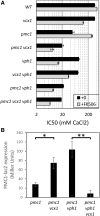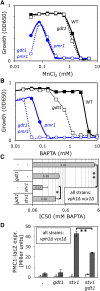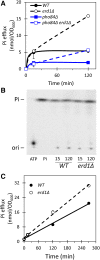H+ and Pi Byproducts of Glycosylation Affect Ca2+ Homeostasis and Are Retrieved from the Golgi Complex by Homologs of TMEM165 and XPR1
- PMID: 29042410
- PMCID: PMC5714488
- DOI: 10.1534/g3.117.300339
H+ and Pi Byproducts of Glycosylation Affect Ca2+ Homeostasis and Are Retrieved from the Golgi Complex by Homologs of TMEM165 and XPR1
Abstract
Glycosylation reactions in the Golgi complex and the endoplasmic reticulum utilize nucleotide sugars as donors and produce inorganic phosphate (Pi) and acid (H+) as byproducts. Here we show that homologs of mammalian XPR1 and TMEM165 (termed Erd1 and Gdt1) recycle luminal Pi and exchange luminal H+ for cytoplasmic Ca2+, respectively, thereby promoting growth of yeast cells in low Pi and low Ca2+ environments. As expected for reversible H+/Ca2+ exchangers, Gdt1 also promoted growth in high Ca2+ environments when the Golgi-localized V-ATPase was operational but had the opposite effect when the V-ATPase was eliminated. Gdt1 activities were negatively regulated by calcineurin signaling and by Erd1, which recycled the Pi byproduct of glycosylation reactions and prevented the loss of this nutrient to the environment via exocytosis. Thus, Erd1 transports Pi in the opposite direction from XPR1 and other EXS family proteins and facilitates byproduct removal from the Golgi complex together with Gdt1.
Keywords: Calcium; Golgi complex; glycosylation; homeostasis; phosphate.
Copyright © 2017 Snyder et al.
Figures







Similar articles
-
A complex genetic interaction implicates that phospholipid asymmetry and phosphate homeostasis regulate Golgi functions.PLoS One. 2020 Jul 30;15(7):e0236520. doi: 10.1371/journal.pone.0236520. eCollection 2020. PLoS One. 2020. PMID: 32730286 Free PMC article.
-
The yeast protein Gdt1p transports Mn2+ ions and thereby regulates manganese homeostasis in the Golgi.J Biol Chem. 2018 May 25;293(21):8048-8055. doi: 10.1074/jbc.RA118.002324. Epub 2018 Apr 9. J Biol Chem. 2018. PMID: 29632074 Free PMC article.
-
Yeast Gdt1 is a Golgi-localized calcium transporter required for stress-induced calcium signaling and protein glycosylation.Sci Rep. 2016 Apr 14;6:24282. doi: 10.1038/srep24282. Sci Rep. 2016. PMID: 27075443 Free PMC article.
-
TMEM165 deficiencies in Congenital Disorders of Glycosylation type II (CDG-II): Clues and evidences for roles of the protein in Golgi functions and ion homeostasis.Tissue Cell. 2017 Apr;49(2 Pt A):150-156. doi: 10.1016/j.tice.2016.06.006. Epub 2016 Jun 16. Tissue Cell. 2017. PMID: 27401145 Review.
-
Insights into molecular and cellular functions of the Golgi calcium/manganese-proton antiporter TMEM165.J Biol Chem. 2024 Aug;300(8):107567. doi: 10.1016/j.jbc.2024.107567. Epub 2024 Jul 11. J Biol Chem. 2024. PMID: 39002685 Free PMC article. Review.
Cited by
-
The putative polyamine transporter Shp2 facilitates phosphate export in an Xpr1-independent manner and contributes to high phosphate tolerance.J Biol Chem. 2025 Jan;301(1):108056. doi: 10.1016/j.jbc.2024.108056. Epub 2024 Dec 9. J Biol Chem. 2025. PMID: 39662831 Free PMC article.
-
Clinical implication of xenotropic and polytropic retrovirus receptor 1 in papillary thyroid carcinoma.Zhejiang Da Xue Xue Bao Yi Xue Ban. 2021 Feb 25;50(1):90-96. doi: 10.3724/zdxbyxb-2021-0052. Zhejiang Da Xue Xue Bao Yi Xue Ban. 2021. PMID: 34117845 Free PMC article. English.
-
New insights into the pathogenicity of TMEM165 variants using structural modeling based on AlphaFold 2 predictions.Comput Struct Biotechnol J. 2023 Jun 17;21:3424-3436. doi: 10.1016/j.csbj.2023.06.015. eCollection 2023. Comput Struct Biotechnol J. 2023. PMID: 37416081 Free PMC article.
-
Regulatory roles of non-coding RNAs in programmed cell death pathways and drug resistance in gastrointestinal stromal tumors.Clin Exp Med. 2025 May 10;25(1):150. doi: 10.1007/s10238-025-01667-2. Clin Exp Med. 2025. PMID: 40347390 Free PMC article. Review.
-
A complex genetic interaction implicates that phospholipid asymmetry and phosphate homeostasis regulate Golgi functions.PLoS One. 2020 Jul 30;15(7):e0236520. doi: 10.1371/journal.pone.0236520. eCollection 2020. PLoS One. 2020. PMID: 32730286 Free PMC article.
References
-
- Arpat A. B., Magliano P., Wege S., Rouached H., Stefanovic A., et al. , 2012. Functional expression of PHO1 to the Golgi and trans-Golgi network and its role in export of inorganic phosphate. Plant J. 71: 479–491. - PubMed
-
- Blomen V. A., Majek P., Jae L. T., Bigenzahn J. W., Nieuwenhuis J., et al. , 2015. Gene essentiality and synthetic lethality in haploid human cells. Science 350: 1092–1096. - PubMed
MeSH terms
Substances
Grants and funding
LinkOut - more resources
Full Text Sources
Other Literature Sources
Molecular Biology Databases
Research Materials
Miscellaneous
